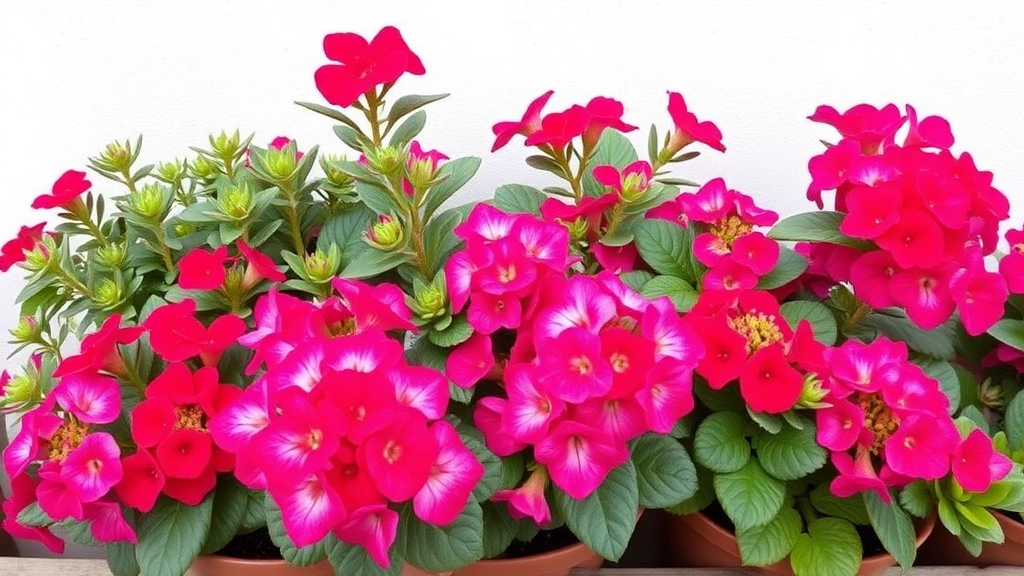Kalanchoe Varieties in Australia
When it comes to Kalanchoe varieties in Australia, there’s a rich selection to explore. From the vibrant Kalanchoe Blossfeldiana, perfect for adding a splash of colour to your home, to the unique Kalanchoe Tomentosa with its fuzzy leaves, these succulents are both beautiful and low-maintenance. If you’re looking to brighten up your indoor spaces or enhance your garden, the diverse range of Kalanchoe varieties available in Australia is sure to impress.
Growing Kalanchoe Plants
Growing Kalanchoe plants in Australia is relatively simple, thanks to their adaptability to different climates. These succulents thrive in well-drained soil and require minimal watering, making them ideal for busy gardeners. Whether you’re a seasoned plant enthusiast or a beginner, understanding the specific needs of each Kalanchoe variety, such as sunlight exposure and watering frequency, will ensure your plants flourish.
Getting Started
Ready to start your Kalanchoe journey? Discover where to buy these stunning plants locally and get tips on how to care for them effectively.
Popular Kalanchoe Varieties in Australia
As we explore the enchanting world of Kalanchoe plants, many of you might be wondering which varieties thrive best in Australia.
Kalanchoes are not just a feast for the eyes; they are also incredibly versatile and easy to care for.
Here are some of the most popular Kalanchoe varieties you can find in Australia:
- Kalanchoe Blossfeldiana: Often seen in homes and gardens, this variety is celebrated for its vibrant blooms and compact size.
- Kalanchoe Tomentosa: Known for its fuzzy leaves and unique appearance, this variety adds a touch of whimsy to any collection.
- Kalanchoe ‘Pink Butterflies’: This delightful cultivar features striking pink foliage, making it a standout choice for indoor spaces. For a detailed propagation method, check out our step-by-step guide on propagating Kalanchoe Pink Butterflies.
- Kalanchoe Fedtschenkoi: With its beautiful, scalloped leaves and clusters of small flowers, it’s a favourite among succulent enthusiasts.
These varieties not only offer stunning aesthetics but also adapt well to various Australian climates. If you’re looking to buy and care for Kalanchoe varieties like the Copper Spoons, you can find more information here.
Ideal Growing Conditions for Kalanchoe Plants
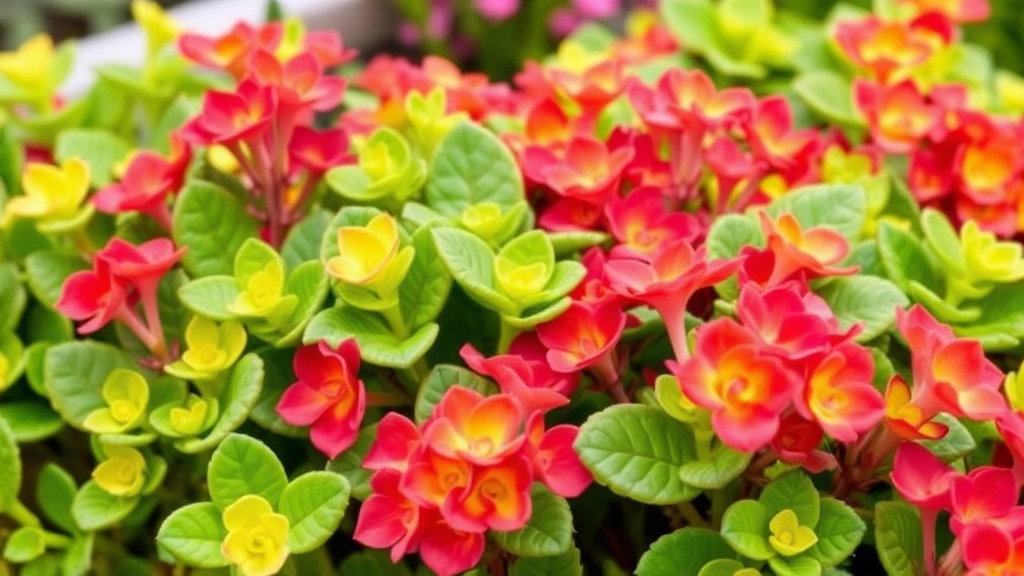
So, you’re keen on nurturing Kalanchoe plants? You’re in for a treat! These vibrant beauties thrive in specific conditions, making them a joy to grow.
What Do Kalanchoe Plants Need?
Let’s dive into the essentials. Here’s how to create the perfect environment for your Kalanchoe:
- Light: Kalanchoe loves bright, indirect sunlight. Think of a sunny windowsill. Too much direct sun can scorch those lovely leaves.
- Temperature: They prefer a warm climate, ideally between 15°C to 25°C. Keep them away from chilly drafts.
- Soil: Well-draining soil is a must! A cactus or succulent mix works wonders. You want to keep those roots happy and dry.
- Humidity: Kalanchoe isn’t picky. Average household humidity is just fine. No need for fancy humidifiers!
- Potting: Choose pots with drainage holes. This helps prevent root rot, which is a common issue.
Watering Tips
- Frequency: Water when the top inch of soil feels dry. Overwatering is a no-go.
- Method: Water deeply but infrequently. Let it soak in and then dry out.
Fertilizing
- When: Feed your Kalanchoe with a balanced, diluted fertilizer during the growing season (spring and summer).
- How: A little goes a long way! Too much can harm your plant.
When it comes to choosing a Kalanchoe variety that seamlessly fits into home decor, [Kalanchoe Blossfeldiana](https://planthq.org/ultimate-guide-to-kalanchoe-blossfeldiana-hybrid-care/) often tops the list.
This charming succulent is not just visually appealing; it’s also known for its vibrant blooms and ease of care.
### Why is Kalanchoe Blossfeldiana so popular?
– **Vibrant Flowers**: The plant showcases clusters of small, bright flowers that can bloom in various colours, including pink, red, yellow, and white.
– **Compact Size**: It typically grows to about 30 cm tall, making it an ideal choice for windowsills and small spaces.
– **Long Blooming Period**: With proper care, Kalanchoe Blossfeldiana can flower for several months, providing continuous colour indoors.
### Care Tips for Kalanchoe Blossfeldiana:
– **Light Requirements**: Place it in a location that receives bright, indirect sunlight for optimal growth.
– **Watering**: Allow the soil to dry out between waterings. Overwatering can lead to root rot.
– **Fertilisation**: Use a balanced fertiliser every few weeks during the growing season to encourage blooming.
I’ve had my own experiences with this variety, and I can attest to its resilience and beauty.
If you’re looking for a plant that adds a splash of colour without demanding too much attention, [Kalanchoe Blossfeldiana](https://planthq.org/care-tips-for-orange-florist-kalanchoe-blossfeldiana/) is a fantastic choice.
Unique Varieties: Kalanchoe Tomentosa and ‘Pink Butterflies’
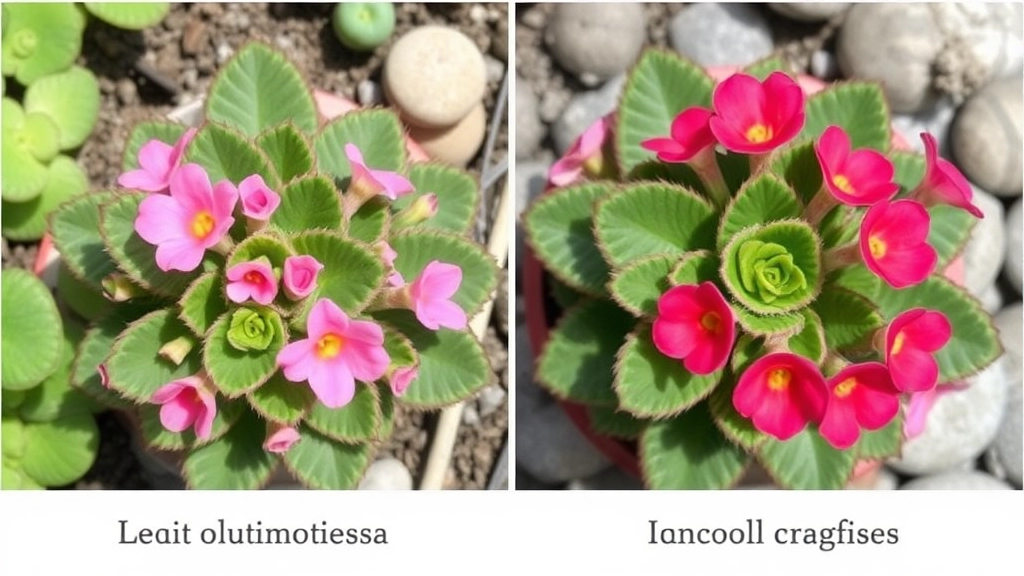
When exploring Kalanchoe varieties, two unique options stand out: Kalanchoe Tomentosa and the delightful ‘Pink Butterflies’.
Are you looking for something distinctive to add to your collection?
Kalanchoe Tomentosa
Commonly known as the ‘Panda Plant’, Kalanchoe Tomentosa is a charming succulent that features fuzzy, grey-green leaves adorned with brown edges. Its soft texture and unique appearance make it an eye-catching addition to any indoor space.
- Fuzzy Leaves: The soft, velvety texture is a standout feature.
- Low Maintenance: Perfect for busy individuals, it thrives with minimal care.
- Drought Tolerant: Requires infrequent watering, making it ideal for beginners.
Kalanchoe ‘Pink Butterflies’
On the other hand, Kalanchoe ‘Pink Butterflies’ offers a vibrant and whimsical touch. This variety showcases stunning, butterfly-shaped leaves that transition from green to a lovely pink hue when exposed to sunlight.
- Striking Appearance: The colourful foliage adds a pop of colour to any setting.
- Easy to Propagate: You can easily grow new plants from leaf cuttings.
- Versatile: Suitable for both indoor and outdoor gardens.
These unique varieties not only bring beauty but also serve as conversation starters.
Low-Maintenance Kalanchoe Types for Indoor Spaces
Are you struggling to find houseplants that require minimal care yet still bring life to your indoor spaces?
Kalanchoe plants are an excellent choice for those seeking low-maintenance greenery.
These resilient succulents thrive in various indoor conditions, making them perfect for busy lifestyles.
Top Low-Maintenance Kalanchoe Varieties
- Kalanchoe Blossfeldiana:
- Known for its vibrant flowers, this variety blooms multiple times a year.
- Requires minimal watering and can thrive in indirect sunlight.
- Kalanchoe Tomentosa (Panda Plant):
- Features fuzzy, grey-green leaves with a unique appearance.
- Very forgiving; it can tolerate neglect and infrequent watering.
- Kalanchoe ‘Pink Butterflies’:
- This variety showcases striking pink edges on its leaves.
- It thrives in bright light but can adapt to lower light conditions.
Care Tips for Indoor Kalanchoe
- Watering:
- Allow the soil to dry out between waterings.
- Overwatering can lead to root rot, so it’s better to err on the side of caution.
- Light Requirements:
- Place your Kalanchoe in a spot with bright, indirect sunlight.
- They can tolerate some direct sunlight but avoid prolonged exposure.
- Soil:
- Use a well-draining potting mix to prevent water retention.
- Cactus or succulent soil works wonders.
Benefits of Low-Maintenance Kalanchoe
- Air Purification:
- These plants can help improve indoor air quality.
- Aesthetic Appeal:
- Their unique shapes and vibrant flowers add a pop of colour to any room.
- Long Lifespan:
- With proper care, Kalanchoe can thrive for several years, providing lasting beauty.
Sunlight and Watering Requirements for Kalanchoe
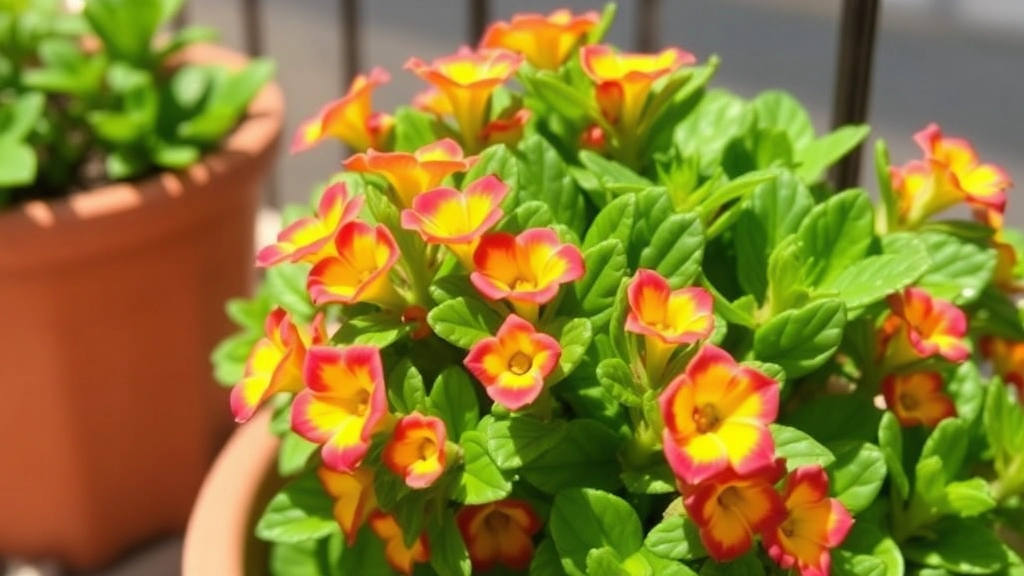
So, you’ve got your Kalanchoe and you’re wondering how to keep it thriving, right?
Let’s dive into the essentials of sunlight and watering for these beauties.
Sunlight Needs
Kalanchoe plants are sun worshippers.
They love bright, indirect sunlight but can also handle a bit of direct sun.
Here’s how to get it just right:
- Location: Place your Kalanchoe near a window where it can soak up the light.
- Duration: Aim for about 6 hours of light a day.
- Signs of Too Much Sun: If the leaves start to look scorched or bleached, it’s time to move it back a bit.
Watering Tips
Now, let’s talk about watering.
Overwatering is a common pitfall for many plant parents.
Here’s the lowdown:
- Frequency: Water your Kalanchoe when the top inch of soil feels dry.
- Amount: Give it a good soak, then let the excess drain out.
- Seasonal Changes: In winter, dial back the watering; Kalanchoe prefers to stay a bit drier during the colder months.
Quick Checklist
- Sunlight: 6 hours of bright, indirect light daily.
- Watering: When the top inch of soil is dry.
- Signs: Watch for yellow leaves (too much water) or scorched leaves (too much sun).
Best Kalanchoe Varieties for Outdoor Gardens
As we delve into the best Kalanchoe varieties suited for outdoor gardens, it’s essential to consider not only aesthetics but also the plant’s adaptability to the Australian climate.
Top Kalanchoe Varieties for Outdoor Spaces
When selecting Kalanchoe for your outdoor garden, look for varieties that thrive in full sun and can withstand occasional drought. Here are some standout options:
- Kalanchoe Blossfeldiana: This vibrant plant boasts clusters of colourful flowers and is a popular choice for outdoor displays. It flourishes in sunny spots and blooms profusely, adding a cheerful touch to any garden.
- Kalanchoe Luciae (Paddle Plant): Known for its striking, paddle-shaped leaves, this variety not only looks great but can also tolerate dry conditions. Its unique foliage can be a focal point in your garden.
- Kalanchoe Fedtschenkoi (Chandelier Plant): With its cascading growth habit, this variety is perfect for hanging baskets or as a ground cover. Its silvery-grey leaves add a lovely contrast to brighter flowers.
- Kalanchoe Thyrsiflora (Flapjack Plant): This variety features thick, fleshy leaves that turn a stunning red under the right conditions. It’s drought-tolerant and thrives in well-draining soil.
- Kalanchoe Pinnata (Mother of Thousands): Known for its ability to produce numerous offsets, this hardy variety is excellent for creating a lush garden. It can handle a variety of conditions, making it quite versatile.
Tips for Successful Outdoor Kalanchoe Gardening
To ensure your Kalanchoe thrives outdoors, consider these key points:
- Soil: Use well-draining soil to prevent root rot.
- Sunlight: Aim for 6-8 hours of direct sunlight daily.
- Watering: Water only when the soil is dry to the touch, as Kalanchoe prefers dry conditions.
By selecting the right varieties and providing optimal care, your outdoor Kalanchoe garden can flourish beautifully. For more detailed guidance, check out our guide on Kalanchoe thriving in full sun and the care tips for Kalanchoe Paddle Plant.
Where to Buy Kalanchoe Plants in Australia
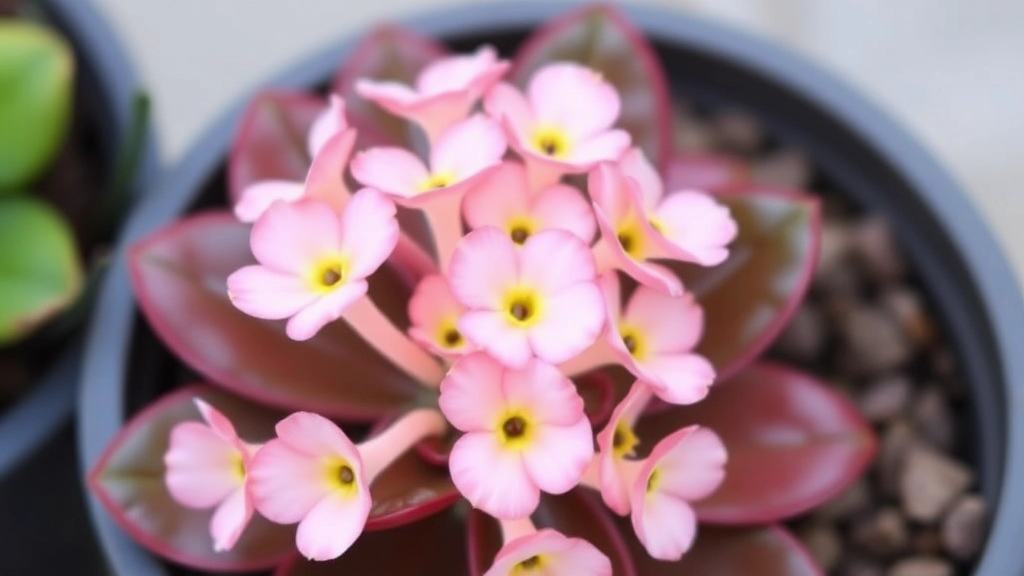
So, you’re ready to add some vibrant Kalanchoe to your home or garden? Great choice! But where do you even start looking for these beauties in Australia?
Local Nurseries and Garden Centres
First up, local nurseries and garden centres are your best bet.
- Personal Touch: You can chat with staff who know their plants inside out.
- Variety: They often have a range of Kalanchoe varieties, from the classic Kalanchoe Blossfeldiana to unique types like Kalanchoe Tomentosa.
Online Plant Retailers
If you prefer shopping from the comfort of your couch, online retailers are a fantastic option.
- Convenience: You can browse different varieties and compare prices easily.
- Home Delivery: Many offer delivery straight to your door.
Some popular online stores include:
- Amazon Australia
- Etsy (for unique or rare varieties)
- Bunnings (a go-to for all things garden)
Specialty Plant Shops
Don’t overlook specialty plant shops, especially those focusing on succulents and indoor plants.
- Expert Advice: Staff usually have a wealth of knowledge and can help you choose the right Kalanchoe for your needs.
- Unique Finds: You might stumble upon rare varieties that you won’t find elsewhere.
Farmers’ Markets
Farmers’ markets can also be a goldmine for Kalanchoe plants.
- Local Growers: You’re supporting local growers and often getting fresher plants.
- Community Vibe: It’s a fun outing, and you can chat with the growers about their care tips.
Social Media and Plant Swaps
Lastly, don’t forget about social media platforms and local gardening groups.
- Facebook Groups: Join local gardening groups where members often sell or swap plants.
- Instagram: Follow local plant enthusiasts who might be selling Kalanchoe plants.
Common Issues and How to Care for Kalanchoe Plants
As we delve into caring for Kalanchoe plants, it’s essential to address common issues that may arise, ensuring your plants thrive.
Common Problems with Kalanchoe
Kalanchoe plants are generally resilient, but they can face challenges that affect their health. Here are some common issues:
- Overwatering: This is the most frequent problem. Kalanchoe prefers dry conditions. Signs include yellowing leaves and root rot.
- Underwatering: Conversely, if left too dry, Kalanchoe can wilt. Look for shrivelling leaves as a warning sign.
- Pest Infestation: Mealybugs and aphids can be problematic. Check for sticky residue or visible pests on the leaves.
- Leaf Drop: This can indicate stress from environmental changes or improper watering.
Effective Care Tips
To keep your Kalanchoe healthy, consider these care tips:
- Watering Schedule: Allow the soil to dry out between waterings. Water thoroughly, then wait until the top inch of soil is dry before the next watering.
- Proper Drainage: Ensure your pot has drainage holes to prevent water accumulation.
- Sunlight: Place your Kalanchoe in bright, indirect sunlight. Too much direct sun can scorch the leaves, while too little can hinder blooming.
- Fertilisation: Use a diluted, balanced fertiliser during the growing season to promote vibrant blooms.
Monitoring Health
Regularly check your Kalanchoe for any signs of distress. Early intervention can prevent small issues from becoming significant problems.
- Inspect Leaves: Look for discolouration or spots.
- Check Soil Moisture: Use your finger to gauge the moisture level in the soil.
By understanding these common issues and implementing effective care strategies, you can enjoy the beauty of Kalanchoe plants for years to come. For more detailed advice on specific issues, check out our guide on why Kalanchoe leaves turn brown and solutions for fixing drooping Kalanchoe leaves.
FAQs about Kalanchoe Varieties in Australia
What are the ideal growing conditions for Kalanchoe plants?
Kalanchoe plants thrive in bright, indirect sunlight, warm temperatures between 15°C to 25°C, and well-draining soil. They are not picky about humidity and should be planted in pots with drainage holes to prevent root rot.
How often should I water my Kalanchoe?
Water your Kalanchoe when the top inch of soil feels dry. Ensure deep watering but allow the soil to dry out between waterings. Overwatering can harm the plant.
What type of fertilizer should I use for Kalanchoe?
Use a balanced, diluted fertilizer during the growing season (spring and summer). Be cautious not to over-fertilize, as too much can harm the plant.
Can you tell me about some unique Kalanchoe varieties available in Australia?
Two unique varieties are Kalanchoe Tomentosa, known for its fuzzy, grey-green leaves with brown edges, and Kalanchoe ‘Pink Butterflies’, which features butterfly-shaped leaves that turn pink in sunlight.
Where can I buy Kalanchoe plants in Australia?
You can purchase Kalanchoe plants from local nurseries, garden centres, online plant retailers like Amazon Australia and Etsy, specialty plant shops, farmers’ markets, and through social media platforms and local gardening groups.
What sunlight conditions do Kalanchoe plants require?
Kalanchoe plants love bright, indirect sunlight and can handle a bit of direct sun. Aim for about 6 hours of light a day. If the leaves look scorched, move the plant to a spot with less direct sunlight.
What are common signs that my Kalanchoe is not getting the right amount of water or sunlight?
Yellow leaves often indicate overwatering, while scorched or bleached leaves suggest too much direct sunlight. Adjust watering and light exposure accordingly to keep your plant healthy.
Are Kalanchoe plants suitable for beginners?
Yes, Kalanchoe plants are low-maintenance and drought-tolerant, making them ideal for beginners. Varieties like Kalanchoe Tomentosa require minimal care and infrequent watering.
Can Kalanchoe be grown both indoors and outdoors?
Yes, Kalanchoe plants are versatile and can be grown both indoors and outdoors, as long as they receive the right amount of light and are protected from extreme temperatures.
How can I propagate Kalanchoe plants?
Kalanchoe plants can be easily propagated from leaf cuttings. Simply cut a healthy leaf, let it dry out for a few days, and then plant it in well-draining soil.
References
-
How to Grow Kalanchoe Succulents
-
Kalanchoe Plant Care: Learn About Growing Kalanchoe Plants
-
Kalanchoe Plant: How to Grow and Care for Kalanchoe
